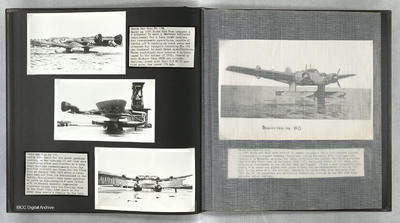Blohm Und Voss HA139
Title
Blohm Und Voss HA139
Description
Photo 1 is a port side view of a HA139 sitting on the water.
Photo 2 is a starboard side view of a HA139 on a harbour jetty.
Photo 3 is a front view of a HA139. It is fitted with a magnetic degausser used in mine sweeping.
Photo 2 is a starboard side view of a HA139 on a harbour jetty.
Photo 3 is a front view of a HA139. It is fitted with a magnetic degausser used in mine sweeping.
Coverage
Language
Type
Format
Three b/w photographs on an album page
Publisher
Rights
This content is available under a CC BY-NC 4.0 International license (Creative Commons Attribution-NonCommercial 4.0). It has been published ‘as is’ and may contain inaccuracies or culturally inappropriate references that do not necessarily reflect the official policy or position of the University of Lincoln or the International Bomber Command Centre. For more information, visit https://creativecommons.org/licenses/by-nc/4.0/ and https://ibccdigitalarchive.lincoln.ac.uk/omeka/legal.
Identifier
PThomasAF20060023
Transcription
[Photograph]
Blohm Und Voss NA 139.
Early in 1935 Blohm Und Voss prepared a a [sic] proposal to meet a Deutsche Lufthansa requirement for a long range seaplane for transoceanic operations, capable of taking off & landing on rough water and stresses for catapult launching. The 139 was designed to meet these specifications. Three prototypes were ordered & building began in the autumn of 1935. Powered by four Junkers Jumo 205C six cylinder engines. Armed with four 7.9 MG machine guns. Max speed 179 mph.
[Photograph]
Blohm Und Voss HA 139.
Having been built for the South American service, on the outbreak of war they were transferred after modification to a long range maritime reconnaissance role. The modified aircraft was flown for the first time on January 19th 1940 after a catapult take off from the Friesenland in the Baltic. The aircraft were again modified to serve as mine-sweepers & were fitted with an unusual magnetic degaussing structure looped from the fuselage nose to the float tips, from there to the outer wing panels & finally to the tail.
[photograph]
Blohm Und Voss NA 139.
Early in 1935 Blohm Und Voss prepared a a [sic] proposal to meet a Deutsche Lufthansa requirement for a long range seaplane for transoceanic operations, capable of taking off & landing on rough water and stresses for catapult launching. The 139 was designed to meet these specifications. Three prototypes were ordered & building began in the autumn of 1935. Powered by four Junkers Jumo 205C six cylinder engines. Armed with four 7.9 MG machine guns. Max speed 179 mph.
[Photograph]
Blohm Und Voss HA 139.
Having been built for the South American service, on the outbreak of war they were transferred after modification to a long range maritime reconnaissance role. The modified aircraft was flown for the first time on January 19th 1940 after a catapult take off from the Friesenland in the Baltic. The aircraft were again modified to serve as mine-sweepers & were fitted with an unusual magnetic degaussing structure looped from the fuselage nose to the float tips, from there to the outer wing panels & finally to the tail.
[photograph]
Collection
Citation
“Blohm Und Voss HA139,” IBCC Digital Archive, accessed November 15, 2024, https://ibccdigitalarchive.lincoln.ac.uk/omeka/collections/document/23141.
Item Relations
This item has no relations.

